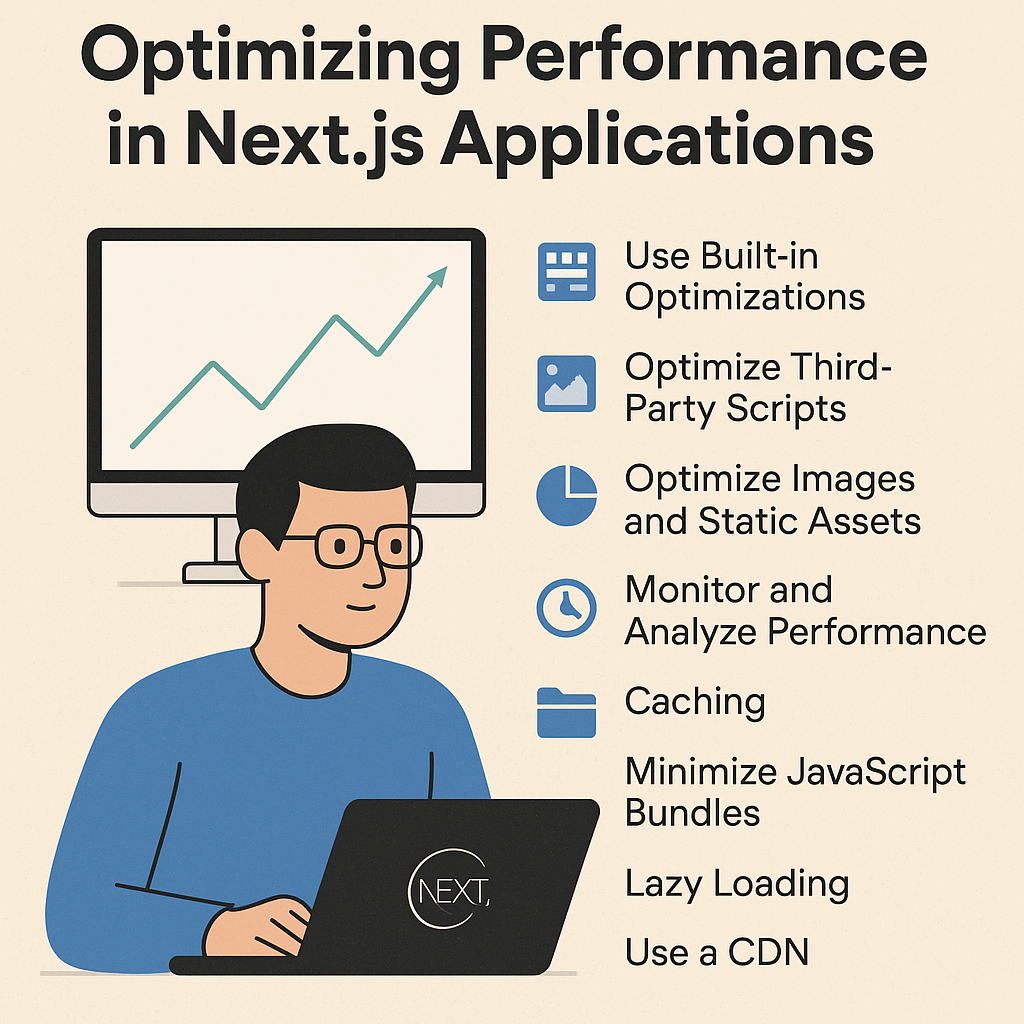Optimizing Performance in Next.js Applications
296 Views
<5 min read
Last updated Loading...

Best Tosan

Real-world lessons often reveal that performance isn't automatic. It’s the result of deliberate, often incremental, decisions. In this guide, we’ll explore how to build faster Next.js applications through strategic choices, measured improvements, and lessons learned from experience.
Why Performance Matters in Next.js
Fast applications retain users, rank higher in search, and reduce server costs. While Next.js includes excellent defaults, its true performance potential is only unlocked through intentional configuration and continuous refinement.
Whether you're building for consumers or internal users, performance directly impacts satisfaction, engagement, and business outcomes. Poor metrics like a slow Largest Contentful Paint (LCP) or First Input Delay (FID) can quietly erode your app’s value—even if everything works.
What Does Optimizing a Next.js App Mean?
Performance Beyond “It Just Works”
Performance optimization in Next.js is the deliberate process of improving speed, load times, interactivity, and resource efficiency. Even though Next.js provides intelligent defaults, thoughtful adjustments are needed to ensure your app meets modern standards like Core Web Vitals.
Built-in Features Worth Leveraging
Next.js includes tools that support performance out of the box:
Automatic code splitting
Optimized image delivery via
next/imageFont and script optimizations
Support for hybrid rendering (SSG, SSR, ISR)
The key is using these tools with intention—otherwise, their benefits may go untapped.
Key Strategies for Next.js Optimization
Identify Performance Goals
Start by defining measurable goals: Is the priority faster page loads, better SEO, or improved responsiveness on mobile? Identify metrics like LCP, CLS, or Time to Interactive and tailor optimizations accordingly.
✱ Early in my transition from Gatsby to Next.js, I ignored Core Web Vitals. It wasn’t until real users complained about slow loads that I realized functionality alone wasn’t enough.
Establish Performance Benchmarks
Before making changes, collect data using Lighthouse, WebPageTest, or browser dev tools. Record key metrics and set improvement targets—for example, reducing LCP from 4s to under 2.5s.
Benchmarks guide your work and make results measurable.
Using Built-in Next.js Optimizations
Take advantage of features like:
Image optimization: Resize, compress, and convert using the
next/imagecomponent.Code splitting: Only send what’s needed per route.
Font inlining: Reduce layout shifts.
Flexible rendering: Choose between SSR, SSG, ISR based on content type.
Using these properly can yield massive gains without adding new dependencies.
Managing Third-Party Scripts
Scripts can add value, but they often come with performance costs. Use next/script with the strategy attribute to control loading:
<Script
src="https://example.com/tracker.js"
strategy="lazyOnload"
/>
Defer or lazy-load non-critical scripts and audit their impact regularly.
Handling Images and Static Assets
Compress assets and prefer modern formats like WebP. The next/image component allows responsive images with automatic format selection:
<Image
src="/hero.webp"
width={1200}
height={600}
priority
alt="Hero Image"
/>
Only preload images that are critical to above-the-fold content.
Monitoring and Analyzing Performance
Use Chrome DevTools, Lighthouse, or the Web Vitals plugin to track:
LCP, FID, CLS
Bundle sizes (via
next buildorwebpack-bundle-analyzer)Server response times
Performance work should be data-driven, not guesswork.
Smart Caching Practices
Use headers and revalidate settings to avoid unnecessary re-renders. Leverage Incremental Static Regeneration (ISR) for dynamic content that doesn’t need full SSR.
Minimizing JavaScript Bundles
Use dynamic imports and React.lazy() to defer large components:
const HeavyComponent = dynamic(() => import('../components/Heavy'), {
ssr: false,
});
Avoid large libraries where a smaller utility can do the job.
Applying Lazy Loading Thoughtfully
Lazy load components that aren't needed immediately—especially modals, carousels, or below-the-fold content. But balance this with user expectations to avoid jank or delays in interactivity.
Optimizing for SEO and Core Web Vitals
Optimize metadata, preload fonts and images, and serve fast HTML. Clean URL structures and a consistent layout improve crawlability and user flow.
Leveraging a CDN
Deploy your Next.js app on platforms like Vercel or Netlify to take advantage of edge caching and fast global delivery. CDN usage reduces latency and improves performance worldwide.
Keeping Dependencies Up to Date
Stay current with Next.js versions and related packages. Updates often include performance improvements and bug fixes that impact real-world load times.
Lessons from Experience
The 50MB Hero Image Debacle
In one project, a home page took nearly 10 seconds to load. After hours of debugging, I found the culprit—a 50MB PNG hero image. Replacing it with a compressed WebP reduced LCP by over 1 second.
Image Format Matters: PNG vs. WebP
WebP and AVIF outperform traditional formats significantly. Even modest size reductions compound across devices and poor networks.
Preloading Assets in Layouts
Placing critical image preloads or font links in layout.tsx ensures key resources are available early—especially for pages users see first.
Improving Over Time
Regular Reviews and Updates
Treat optimization as an ongoing task, not a one-time fix. As your app grows, re-run audits and clean up obsolete or bloated code.
Using Metrics to Guide Changes
Track key metrics like:
JavaScript bundle size
API response times
Web Vitals (LCP, FID, CLS)
Unused code and third-party script impact
Use these to prioritize what to fix next and justify performance work.
Benefits of Next.js Performance Optimization
Faster Load Times → Happier users, better engagement
Improved SEO → Better ranking and discoverability
Scalability → Lightweight pages perform consistently as traffic grows
Developer Confidence → Clean, fast codebases are easier to maintain
Final Tips for Optimization
Use WebP or AVIF for images
Document why each performance decision was made
Preload critical resources, but only what’s needed
Optimize based on real user needs (mobile vs desktop, internal vs public)
Use automation (e.g., Lighthouse in CI/CD) to catch regressions early
Conclusion
Optimizing a Next.js application requires strategy, patience, and iteration. While the framework offers powerful defaults, performance doesn’t improve on its own. By applying the right tools, learning from missteps, and treating optimization as a regular part of development, you’ll build faster, more scalable, and more reliable apps.
Performance isn’t just a technical checkbox—it’s a product feature. And in many cases, it’s the one that users notice most.
React
Frontend
Next.js
Optimization
JavaScript
Comments ( )
0 Likes
Comment
Categories
Latest Posts
Related Posts
No related posts!
